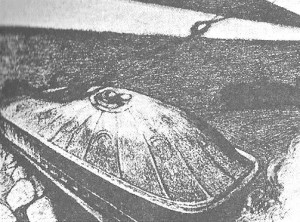
Was the technology described by H.G. Wells in his fiction merely redolent of his times, or did he genuinely extrapolate alternate 19th century technology such as a modern Steampunk author might? A bit of both, actually.
THE WAR OF THE WORLDS (1898), in envisioning the technology of the Martians, portrays an alternate system of mechanics more advanced than 19th century technology. Never mind the heat ray, which is pure speculation for the time. Consider the actual fighting machine the Martians deploy:
“Seen nearer, the thing was incredibly strange, for it was no mere insensate machine driving on its way. Machine it was, with a ringing metallic pace, and long flexible glittering tentacles (one of which gripped a young pine tree) swinging and rattling about its strange body. It picked its roads as it went striding along, and the brazen hood that surmounted it moved to and fro with the inevitable suggestion of a head looking about it. Behind the main body was a huge thing of white metal like a gigantic fisherman’s basket, and puffs of green smoke squirted out from the joints of the limbs as the monster swept by me. And in an instant it was gone.”
This implies the machine is itself possessed intelligence, or is perhaps a Waldo-like device directed by one of the Martians. Wells’ narrator speculates:
“I began to ask myself what they could be. Were they intelligent mechanisms? Such a thing I felt was impossible. Or did a Martian sit within each, ruling, directing, using, much as a man’s brain sits and rules in his body? I began to compare the things to human machines, to ask myself for the first time in my life how an ironclad or a steam-engine would seem to an intelligent lower animal.”
This is groundbreaking stuff, and eerily prescient of the kind of technology we are rather foolishly rushing headlong to develop today. Yet there are elements of Wells’ vision beyond anything we conceive today. One scene has always stuck in my head since I first read it:

“I fell helplessly, in full sight of the Martians, upon the broad, bare gravelly spit that runs down to mark the angle of the Wey and Thames. I expected death… I have a dim memory of the foot of a Martian coming down within a score of yards from my head, driving straight into the loose soil, whirling it this way and that, and lifting again…”
Precisely how was this mechanism articulated? The main character explains:
“And of their appliances, perhaps nothing is more wonderful to a man than the curious fact that what is the dominant feature of almost all human devices in mechanisms is absent – the WHEEL is absent; amongst all the things they brought to Earth there is no trace or suggestion of their use of wheels. One would at least have expected it in locomotion… not only did the Martians either not know of (which is incredible) or abstain from the wheel, but in their apparatus singularly little use is made of the fixed pivot, or relatively fixed pivot, with circular motions thereabout confined to one plane. Almost all the joints of the machinery present a complicated system of sliding parts moving over small, but beautifully curved friction bearings.”
Now this is a phenomenal concept; mechanisms without wheels, not even toothed gears. I defy any Steampunk enthusiast to design a machine of this nature!
Wells describes another aspect of Martian technology which remains unique, even to this day, as far as I am aware:

“…the long leverages of their machines are in most cases actuated by a sort of sham musculature of discs in an elastic sheath; these discs are become polarized and drawn closely and powerfully together when traversed by a current of electricity. In this way the curious parallelism to animal motions, which was so striking and disturbing to the human beholder, was attained. Such quasi-muscles abounded in the crab-like Handling Machine which I watched unpacking the cylinder… It seemed infinitely more alive than the actual Martians lying beyond it in the sunset light, panting, stirring ineffectual tentacles, and moving feebly, after their vast journey across space.”
The general concept of machines seemingly more alive than their creators we are perilously close to achieving today. This does not bode well for our future, methinks.
Let me turn to one of Wells’ short stories for an example of extrapolated contemporary technology. In THE LAND IRONCLADS (1903) he anticipates the modern tank, but in a slightly silly way:
“It might have been from eighty to a hundred feet long… its vertical side was ten feet high or so, smooth for that height, and then with a complex patterning under the eaves of its flattish turtle cover. This patterning was a close interlacing of port-holes, rifle barrels, and telescope tubes – sham and real – indistinguishable from one another. The thing had come into such a position as to enfilade the trench…”
In other words, massive as this machine was, it was armed with nothing but rifles. It does not seem to have occurred to Wells to equip it with light artillery or Maxim guns, the machine guns of the day. Still, tactically, it enable riflemen to dominate a trench filled with enemy soldiers and either kill them or drive them off, so useful enough.
As to its method of locomotion:
“The monster had moved. It continued to move regardless of the hail that splashed its skin with bright new specks of lead. It was singing a mechanical little ditty to itself, ‘Tuf-tuf, tuf-tuf, tuf-tuf,’ and squirting out little jets of steam behind. It had humped itself up, as a limpet does before it crawls, it had lifted its skirt and displayed along the length of it – FEET! They were thick, stumpy feet, between knobs and buttons in shape – flat, broad things, reminding one of the feet of elephants or the legs of caterpillars; and then, as the skirt rose higher, the war correspondent, scrutinizing the thing through his glasses again, saw these feet hung, as it were, on the rims of wheels.”
“Mr Diplock,” he said, “and he called them Pedrails… Fancy meeting you here!”
In other words, Wells had taken a well-known experimental device invented by a certain Mr. Diplock (I’ve seen photographs of his contraption) and extrapolated it into a slow but fearsome fighting machine.

I think Wells then got carried away with working out the details aiming the rifles, details which – while needlessly complicated – are a marvelous alternate technology that almost makes sense:
“The sighting was ingeniously contrived. The rifleman stood at the table with a thing like an elaboration of a draughtsman’s dividers in his hand, and he opened and closed these dividers, so that they were always at the apparent height – if it was an ordinary sized man – of the man he wanted to kill. A little twisted strand of wire like an electric light wire ran from this implement up to the gun, and as the dividers opened and shut the sights went up or down. Changes in the clearness of the atmosphere, due to changes of moisture, were met by an ingenious use of that meteorologically sensitive substance, catgut, and when the land ironclad moved forward the sights got a compensatory deflection in the direction of its motion.”
“The rifleman stood up in his pitch dark chamber and watched the little picture before him. One hand held the dividers for judging distance, and the other grasped a big knob like a door-handle. As he pushed this knob about the rifle above swung to correspond, and the picture passed to and fro like an agitated panorama. When he saw a man he wanted to shoot he brought him up to the cross hairs, and then pressed a finger upon a little push like an electric bell-push, conveniently placed in the centre of the knob. Then the man was shot. If by any chance the rifleman missed his target he moved the knob a trifle, or readjusted his dividers, pressed the push, and got him the second time.”
While technologically suspect – I still don’t have a clear idea how the darn thing actually works despite the lengthy description – this vision of a weapon remotely controlled by an operator in utter safety (in this case protected by 12 inches of iron plating) meticulously picking off his enemies is frightening familiar in this modern era of remote-controlled armed drones. Substitute a computer screen for the camera-obscura and a joystick for the ‘dividers’ and ‘big knob’ and you have the very essence, the very indifference, of modern warfare. Wells was way ahead of his time, in sensibility, if not in technology.
And still I am left with the annoying impression that, if technical conundrums were resolved, the gizmo described by Wells might well have been possible and put in use in some kind of alternate world.
Though in reality, had such a massive, armoured self-propelled vehicle been invented at the time, to save money and prevent endless breakdowns of complicated mechanism the British army would simply have left slits in the side and told their riflemen to fire through them as best they could. After all, plenty more riflemen available if need be. No need for any camera-obscura contraptions. Today the opposite point of view seems to have taken hold of military planners. The goal is to remove the soldier entirely from the battlefield. Scary.
Let me conclude with one last bit of charming technological extrapolation by Wells, namely the first use of an atomic bomb in literature, albeit one that seems more Steampunk (in the preponderant significance of the human element) in nature than modern push-button warfare.
This is from his novel THE WORLD SET FREE (1914):

“…The gaunt face hardened to grimness, and with both hands the bomb-thrower lifted the big atomic bomb from the box and steadied it against the side. It was a black sphere two feet in diameter. Between its handles was a little celluloid stud, and to this he bent his head until his lips touched it. Then he had to bite in order to let the air in upon the inducive. Sure of its accessibility, he craned his neck over the side of the aeroplane and judged his pace and distance. Then very quickly he bent forward, bit the stud and hoisted the bomb over the side.”
“Round,’ he whispered inaudibly.”
“The bomb flashed blinding scarlet in mid-air and fell, a descending column of blaze eddying spirally in the midst of a whirlwind… It was looking down upon the crater of a small volcano. In the open garden before the Imperial castle a shuddering star of evil splendour spurted and poured up smoke and flame towards them like an accusation. They were too high to distinguish people clearly, or mark the bomb’s effect upon the building until suddenly the façade tottered and crumbled before the flare as sugar dissolves in water…”
In other words, Wells envisioned an atomic explosion as a continuous chain reaction, dissolving the local landscape like an ever widening volcano, though eventually winding down because “every seventeen days its power is halved, though constantly it diminishes toward the imperceptible, is never entirely exhausted, and to this day the battlefields and bomb fields of that frantic time in human history are sprinkled with radiant matter and so centres of inconvenient rays…”
I imagine one must wear special leather gloves to pick up an atomic bomb and throw it over the side of an aeroplane cockpit. Special goggles too. And such bomb throwers would no doubt be considered members of an elite fraternity. Or perhaps they would be shunned, as a sort of modern untouchable?
At any rate, there’s definitely a whiff of Steampunkery about Wells’ concept of an atomic bomb. Indeed, about many of his concepts. I declare he qualifies.
H.G. Wells is definitely a Steampunk kind of guy in my books.










